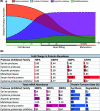The molecular basis of cereal grain proteostasis
- PMID: 35818971
- PMCID: PMC9400069
- DOI: 10.1042/EBC20210041
The molecular basis of cereal grain proteostasis
Abstract
Storage proteins deposited in the endosperm of cereal grains are both a nitrogen reserve for seed germination and seedling growth and a primary protein source for human nutrition. Detailed surveys of the patterns of storage protein accumulation in cereal grains during grain development have been undertaken, but an in-depth understanding of the molecular mechanisms that regulate these patterns is still lacking. Accumulation of storage proteins in cereal grains involves a series of subcellular compartments, a set of energy-dependent events that compete with other cellular processes, and a balance of protein synthesis and protein degradation rates at different times during the developmental process. In this review, we focus on the importance of rates in cereal grain storage protein accumulation during grain development and outline the potential implications and applications of this information to accelerate modern agriculture breeding programmes and optimize energy use efficiency in proteostasis.
Keywords: cereal grain development; proteases; proteostasis; storage protein.
© 2022 The Author(s).
Conflict of interest statement
The authors declare that there are no competing interests associated with the manuscript.
Figures



Similar articles
-
The aleurone layer of cereal grains: Development, genetic regulation, and breeding applications.Plant Commun. 2025 Apr 14;6(4):101283. doi: 10.1016/j.xplc.2025.101283. Epub 2025 Feb 12. Plant Commun. 2025. PMID: 39949062 Free PMC article. Review.
-
Protein accumulation in aleurone cells, sub-aleurone cells and the center starch endosperm of cereals.Plant Cell Rep. 2014 Oct;33(10):1607-15. doi: 10.1007/s00299-014-1651-2. Epub 2014 Jul 15. Plant Cell Rep. 2014. PMID: 25023874 Review.
-
Imaging the ER and Endomembrane System in Cereal Endosperm.Methods Mol Biol. 2018;1691:251-262. doi: 10.1007/978-1-4939-7389-7_20. Methods Mol Biol. 2018. PMID: 29043684
-
Differential representation of albumins and globulins during grain development in durum wheat and its possible functional consequences.J Proteomics. 2017 Jun 6;162:86-98. doi: 10.1016/j.jprot.2017.05.004. Epub 2017 May 3. J Proteomics. 2017. PMID: 28478307
-
Orchestrating seed storage protein and starch accumulation toward overcoming yield-quality trade-off in cereal crops.J Integr Plant Biol. 2024 Mar;66(3):468-483. doi: 10.1111/jipb.13633. Epub 2024 Feb 26. J Integr Plant Biol. 2024. PMID: 38409921 Review.
Cited by
-
Prediction of new candidate proteins and analysis of sub-modules and protein hubs associated with seed development in rice (Oryza sativa) using an ensemble network-based systems biology approach.BMC Plant Biol. 2025 May 8;25(1):604. doi: 10.1186/s12870-025-06595-7. BMC Plant Biol. 2025. PMID: 40340735 Free PMC article.
References
-
- Bogard M., Allard V., Brancourt-Hulmel M., Heumez E., Machet J.M., Jeuffroy M.H.et al. . (2010) Deviation from the grain protein concentration-grain yield negative relationship is highly correlated to post-anthesis n uptake in winter wheat. J. Exp. Bot. 61, 4303–4312 10.1093/jxb/erq238 - DOI - PubMed
Publication types
MeSH terms
Substances
LinkOut - more resources
Full Text Sources

